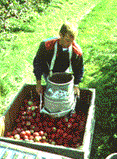Discover one of Vermont's Largest Collections of Ornamental
Plants
 The
University of Vermont Horticultural Research Center, also known as the "Hort.
Farm," is home for many trees, shrubs, perennials, apples and small fruit. More than
700 kinds of ornamental trees and shrubs, many of them uncommon or unique, are planted at
the Hort. Farm. One of the largest known mature ornamental crabapple collections in the
Northeast is located here. The
University of Vermont Horticultural Research Center, also known as the "Hort.
Farm," is home for many trees, shrubs, perennials, apples and small fruit. More than
700 kinds of ornamental trees and shrubs, many of them uncommon or unique, are planted at
the Hort. Farm. One of the largest known mature ornamental crabapple collections in the
Northeast is located here.
Purchased in the early 1950s, the 97-acre Hort. Farm is used for
agricultural research and instruction of UVM classes, and by professional plant
organizations and gardening groups. For over 40 years, University horticulturists have
been testing new and unusual plants for their adaptation to the Vermont environment,
especially to our cold winters. Many journal and popular articles have been published on
the research performed at the
Horticultural Research Center.
The Hort. Farm is open to visitors Monday-Friday, 8 a.m.-4 p.m., and
for special events (closed on holidays and some weekdays). (directions) You are asked to
sign in at the Blasberg Building before beginning your tour of the property. There is a
"Woodland Walk" which is a self-guided tour that encounter and describes the
collections in detail.
For information about the Hort. Farm, contact Greg Eurich, Horticulture
Farm Manager at 658-9166. For information about workshops or special events, contact
The Friends of the Horticulture
Farm (864-3073).
Special Collections and Points of Interest:
- Crabapple Collection - The crabapple collection of over 120
different kinds of mature crabapple trees is one of the largest in the Northeast. A
special open house is held in May when the crabapples are in bloom. In autumn, crabapples
have colorful foliage and showy fruit.

- Apples - Ongoing research
is being conducted on apple scab, apple replant disease, cultivar/rootstock combinations,
and the Vermont Lattice System (a new training system for growing apple trees).
Scab-resistant apple varieties are tested and evaluated.
- Lilac Collection - The lilac collection includes 90 kinds of lilacs
ranging from 3 feet to 15 feet in height, and having a multitude of colors. Most of the
lilacs are in bloom in late May.
- Juniper Collection -The juniper collection includes 60 kinds of
junipers. They range from spreading groundcovers to tree size, and vary in shape and
color.
- Other Woody Plant Collections - Rhododendrons, conifers, viburnums
and many other kinds of trees and shrubs are represented in the plant collections.
- Perennials - A display
border of a large number of labeled perennial plants useful in Vermont gardens is located
near the parking area. Research on perennials has included cut flower studies, hardiness
trials and disease control of mildew on phlox. Asters and solidago (goldenrod) are being
evaluated for their characteristics, hardiness and potential uses.
- Natural Areas - The woodlands, meadows, ponds and orchards offer a
diverse habitat for wildlife. The Hort. Farm is a favorite stopover for migrating birds.
|